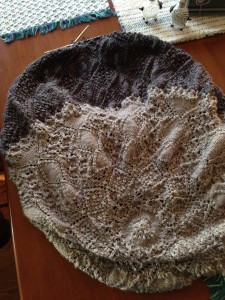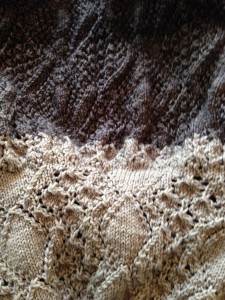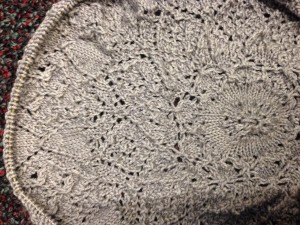Back in January, I posted about this project, the Event Horizon Shawl from “Stories in Stitches 2”, by Donna Druchunas. I didn’t actually finish by 3/14, so I missed Pi Day. But considering everything else I’ve been working on (super-fun secret projects- more on them, later), I think I did pretty well to make it to the border.
String Theory Caper sock yarn is delightful to work with, and perfect for this lace work. Donna based the pattern on lace designs by Dorothy Reade, who was a lace genius. Lace is full of yarn-overs, to create the holes. In this design you knit them through the back of the loops on the next row, which gives them a really crisp quality. The holes are still there, but just a little tightened. Combined with the rather firm yarn, this makes a fabric that is lacy but not delicate. I won’t have to worry about the fabric catching on things and getting distorted. Even unblocked, it is the coziest knitting imaginable, and I am loving having it on my lap. Good thing, because even though I am done with all of the charts, the border is going to take a long time to knit. I’ve used three skeins of yarn for the body, and the border takes the entire 4th skein. So I am only 75% of the way done!
I’m about to set out on some teaching adventures, and I am not sure this is good travel knitting. If I have room, I am going to pack it anyway, because there might be time to knit in the hotel room, and I don’t want to stop!

575 sts on the needles. The body is finished, but the border is 25% of the shawl, so I am not nearly done. All of the colors have the same yardage, so the light gray portion has the same number of stitches as the medium and dark gray stripes. Increasing the number of sts really affects the color placement dramatically.

The colors shift on a gradient, from light gray in the center, through medium and dark gray. The border will be black. In close-up, you can see the colors better. On the needles, the light gray dominates, because there are so many more rows of the light color (less sts in each row)

The beginning goes so fast! The center is really pretty. Once the shawl gets big, the center gets a bit lost, so I like to appreciate it at this point.

